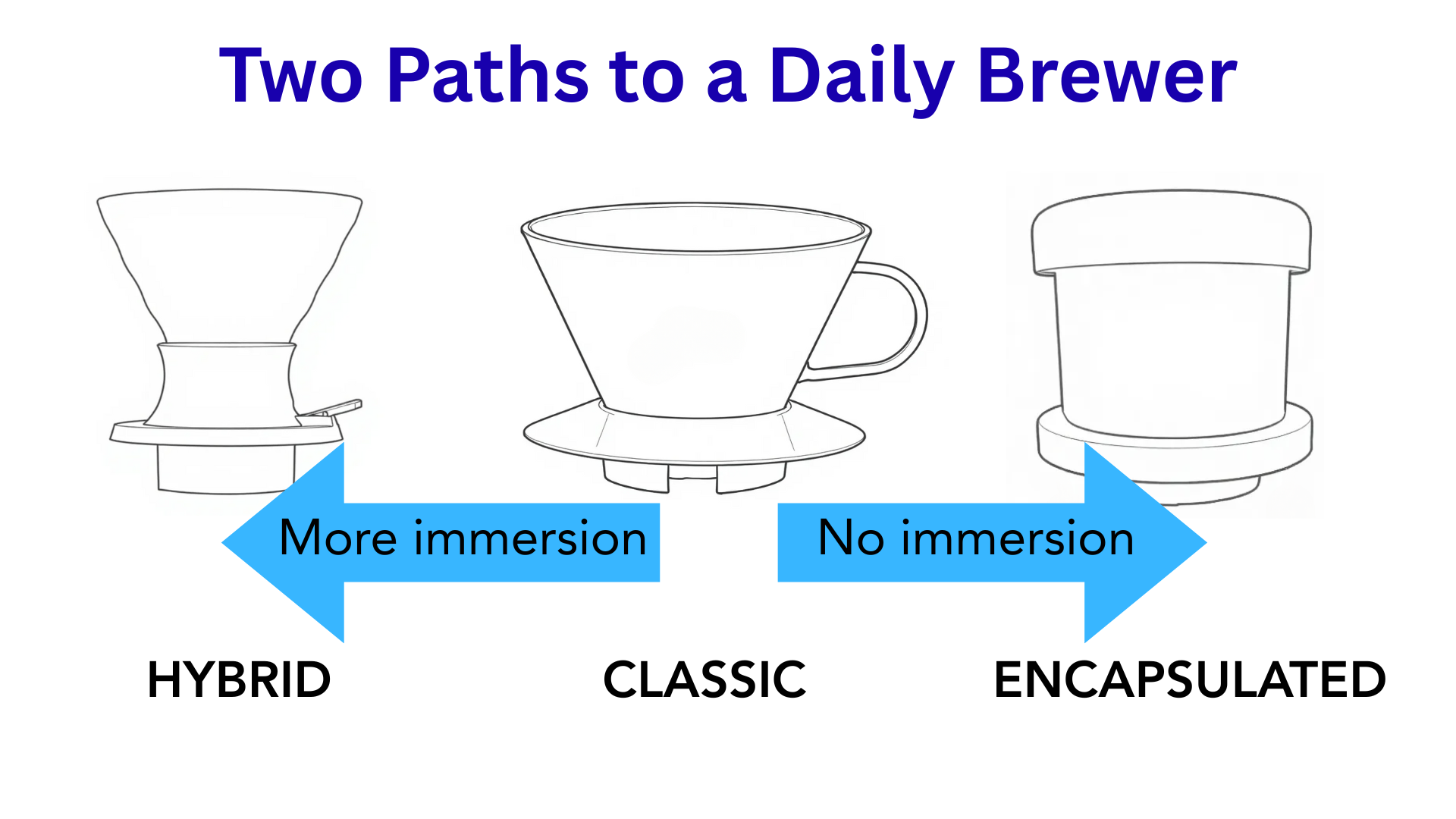Two Paths to a Simplified Daily Brewer
Ask most coffee enthusiasts what brewer showcases a coffee’s full potential, and you’ll often hear similar answers: the Harrio V60, the Kalita Wave, or other conical and flat-bottom drippers. These brewers have earned their place as the gold standard for clarity and complexity in the cup. But as anyone who’s wrestled with a channeling or choking brew knows, they can demand skill, patience, and attention. Perfect cups are possible—but they’re also easy to miss.
Traditional pour-over brewers like the V60 succeed because of their open bed and responsive flow. But they also highlight every variable: grind size, pouring pattern, flow rate, agitation and so on. A small slip—a faster pour, an uneven spiral—can shift flavor from sweet and lively to sour or bitter.
Daily Brews
For many, making their daily brew means working towards an enjoyable cup that does a good job representing the coffee selected, rather than a quest for perfection. For everyday use, traditional brewers can be seen - by some, others love the process - as fussy and impractical. Ease of use and consistency are often overriding considerations for a ‘daily driver’.
Over the past two decades, the coffee world has steadily embraced alternative brewers that address these goals. First came immersion–percolation hybrids like the Clever Dripper (introduced in the mid-2000s), then refinements such as the Hario Switch (around 2018). These brewers built a reputation by reducing the dependency on pouring technique while still delivering flavorful, filtered coffee. Today, they’re well-established.
The Hybrid Approach: Increase Immersion
Any brewer that has a coffee slurry above the coffee bed has some degree of immersion brewing. Even the classic V60, which is clearly a percolation brewer – with gravity drawing water down through the coffee bed to effect extraction – has some immersion extraction taking place in the coffee slurry.
The Hybrid Approach is to increase the amount of immersion-based extraction by interrupting the flow of water with a valve. The immersion phase – which is just like using a French Press – is typically followed by a draw down giving a percolation extraction.
Some recipes have been designed to do an initial percolation first – leaving the valve open – followed by an immersion and final draw down (for instance, see The Coffee Chronicler video The ultimate Hario Switch RECIPE: A consistent cup that will blow your mind). This is reported to give some of the brightness associated with classic pour-over coupled with the fuller body from an immersion brew.
The main functional advantage of Hybrid Brewers is that they are less sensitive to user technique. Users can steep the coffee grounds without worrying about perfect timing or water flow.
Pulsed pours are still the main recommendation, requiring users to weigh the water being added for each phase, but the actual pouring technique (e.g. flow rate and circular motion) is not that critical.
The Clever Dripper and Hario Switch are two examples that show how hybrid brewing has matured into a trusted alternative to classic pour-over, reducing complexity without sacrificing quality. Their longevity proves that coffee drinkers value reliability and approachability in daily brewing.
The Encapsulation Approach: Eliminate Immersion
Encapsulated Pour-Over (EPO) devices like the SSC Brewer pursue an alternative path to consistency and simplicity of use, taking the diametrically opposite approach to hybrid brewers – they eliminate the immersion extraction completely. Though the goal of the design is to control the coffee bed, a consequence is that immersion is not a factor.
Water in a SSC Brewer.
This is achieved by a fundamental change in the pour-over process; instead of pouring water onto a loose coffee bed – which then requires complex pulsed pouring to help manage channel formation and issues with fines migration, among other things – the water is poured onto an encapsulated coffee bed. This uses the natural property of ground coffee – that is, its expansion in hot water (by about 50% by volume) - to create a perfectly uniform coffee bed. This is ideal for percolation extraction as it is uniformly dense and deep. It self closes any channels that try to form (as the coffee is expanding) and holds nearly all fines in place.
Functionally it is difficult to think of an easier brewer to use. As long as the coffee is put in the brewer correctly – right dose, grind size, shaken level and the plate inserted – the water can be poured in any way … you can use a saucepan if you have to!
There is no need to time or measure anything with the SSC Brewer. It just needs to be filled with hot water.
Where Hybrid Brewers reduce reliance on skill, EPO almost eliminates it, guaranteeing repeatability through its physical structure.
Which Brewer Fits Your Daily Life?
Choose Hybrid if you:
Like to adjust steep times and experiment.
Enjoy a hands-on ritual that’s forgiving.
Want a balance of immersion body and filter clarity.
Choose Encapsulated Pour-Over if you:
Want the simplest process possible.
Don’t want to worry about pouring technique or precision.
Prefer clean, balanced flavors without effort.
Alternatives?
So, there are at least two diametrically opposite approaches to simplifying the pour-over brewing process - adding additional immersion and removing it completely. It will be interesting to see if other approaches are developed.
It’s debatable whether ‘press’ type brewers – e.g. Aeropress – are modifications to pour-over or a completely different. I lean to it being the latter, as it introduces pressurization.
I don’t think pour assist tools like the Melodrip or the reservoir in the Oxo Brewer are anything more than simple ways to help get a pouring technique that wors with traditional pour-over.
Are there others out there now … or in development?


